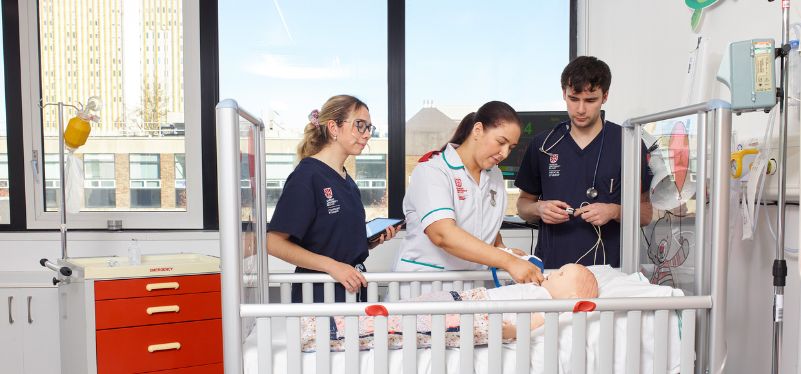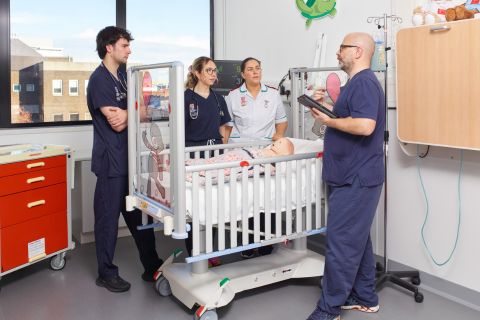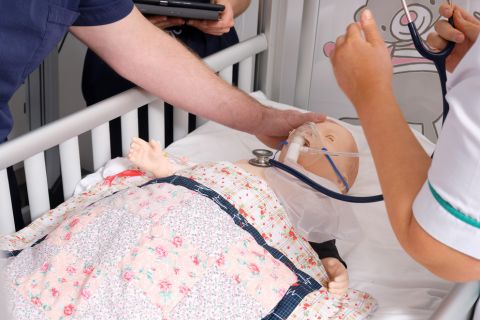Adventures In... Simulation
The inter-professional simulation centre – InterSim – is giving Queen’s students a vital and unique edge.

When Professor Gerry Gormley sat in JFK airport in 2017 and sketched out his vision for a cross-disciplinary simulation centre at Queen’s, he had no idea just how accurate his drawing would turn out to be. Or, indeed, the impact it would have on the students who would benefit.
“I just thought: ‘Wow,’” says Pharmacy student Elia Tutty, remembering how awestruck she was on her first visit to the KN Cheung SK Chin InterSim Centre – known, simply, as InterSim.
“It’s like going into a hospital ward – both the sounds you can hear and what you see – all your senses are heightened. It all feels so real.”
If it sounds impressive, it’s because it is. A safe, immersive environment, InterSim enables medical, nursing, pharmacy, dentistry and midwifery students to participate in simulations that prepare them for a real-world workplace. It means that when they begin their healthcare careers, they are ready to hit the ground running.

Professor Gerry Gormley, James Crosfield, Elia Tutty and Caoimhe McMullan at one of InterSim's simulation wards.
Before a single brick was laid, the team spent nearly three years getting the needs right – and they didn’t just visit other simulation facilities, they also considered theatrical theatres too. “We had to remember that this is a performance space to enable the best of learning,” explains Professor Gormley, Chair in Simulation and Clinical Skills, and Interim Director of InterSim.
“For us, it’s not just about the tech – though ours is cutting edge – it’s also about how we teach our students. InterSim takes their development to the next level.”
Traditionally, simulation has been used in specialities such as emergency medicine and anaesthetics, but InterSim is also a space for a range of healthcare areas, including mental health, palliative and primary care. Fifth Year medical student James Crosfield believes being able to work with students from other disciplines is what makes InterSim so special.
“It’s a brilliant sandbox where you learn the things you can’t get from a textbook,” says James.
“It’s not like being in hospital with five seasoned veterans working away and you’re just watching. At InterSim you’re at the centre of it – giving the instructions and communicating with people who may go on to be your future colleagues. That’s a very hard thing to learn without doing it – and it’s even harder to do in a real environment when the stakes are so high.”

For Jade Flaherty, a Third Year Nursing student, InterSim has also boosted her self confidence. On a recent A&E placement, Jade was part of a standby call for a trauma response. “I got so nervous because I didn’t know how unwell or injured the patient would be. But I was able to contribute to the best of my abilities because InterSim simulation had helped build my confidence. I could see for the first time why Professor Gormley had described how we interact together as a dance – and see how the different disciplines worked together in practice.”
For Elia, that inter-professional interaction is also a key driver. When she graduates in 2026, she will be one of the first wave of pharmacists with new prescribing powers. “To get that experience of working alongside nursing and medical students, and having the opportunity to raise awareness of our new prescribing ability, is a way of transforming the healthcare system in years to come. If we have that best practice of working together at undergrad level, it will translate into the working world when we graduate.”
All three students’ real-world practice will be informed by their InterSim experiences. In fact, James can’t imagine graduating now without it. “It would be like doing a sky dive without practising first,” he says.
Though Professor Gormley’s original drawing of the centre turned out to be incredibly accurate – the learning conversation suites, the simulated participant rooms, and the “cave” (a highly immersive virtual environment) – if he were to pick up another piece of paper to sketch the future, what would he draw this time? Not the building.
“The next big step will be to develop our educators and nurture the next generation of simulation academics – InterSim Fellows, healthcare professionals who can take time out of their training or practice to work with the team for a year,” he explains.
They will be trained in the discipline of simulation and grow their skills to help sustain the facility into the future. Because what InterSim understands better than anything is that its power is its people. “After all, education doesn’t change the world,” says Professor Gormley, “it changes the people that change the world. So, here we create the conditions for people to do just that.”
Find out how you can support the InterSim Centre here